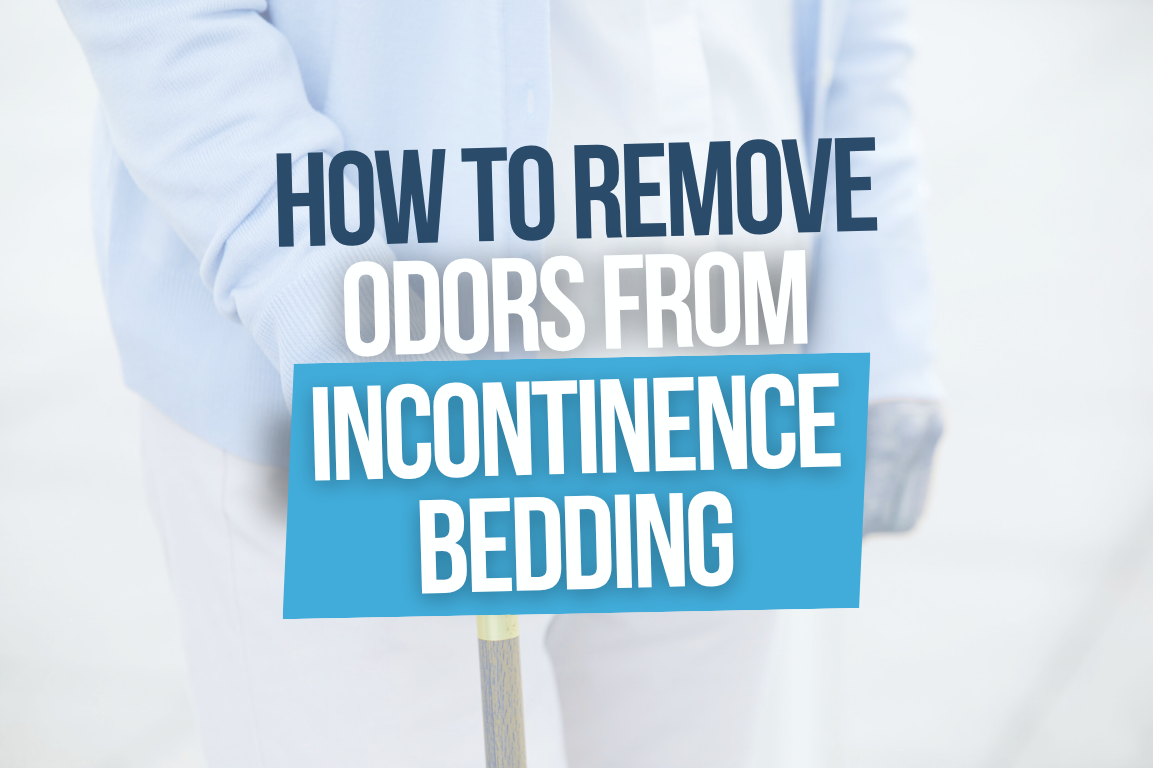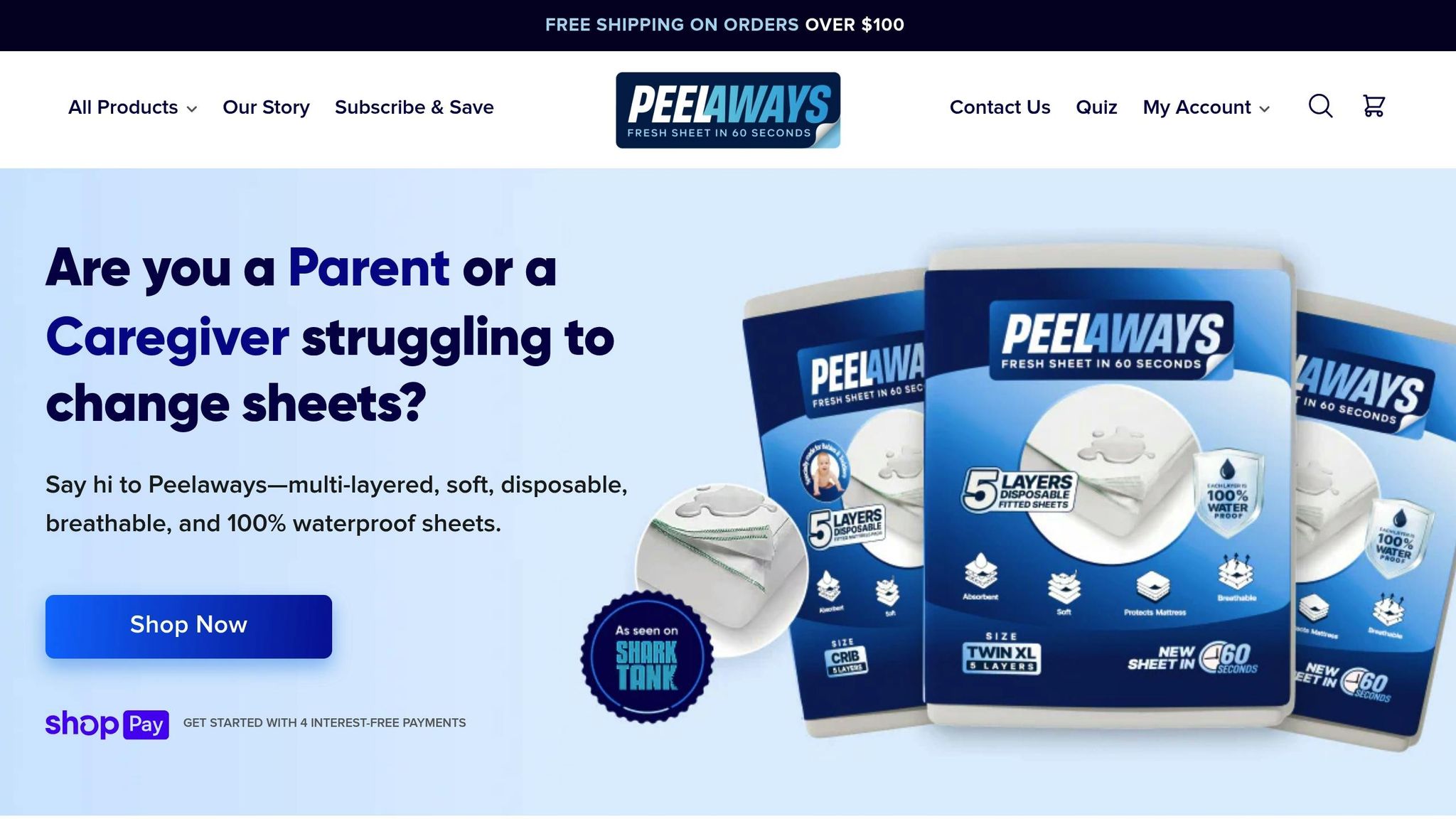How to Remove Odors from Incontinence Bedding

Urine odors in bedding can be tough, but they’re manageable with the right steps. Acting quickly, using enzyme-based cleaners, and washing effectively are key. Add protective products like waterproof mattress covers and disposable sheets to prevent smells from setting in. Here’s how you can tackle it:
- Quick Action: Blot spills immediately to stop absorption. Pre-treat stains with enzyme cleaners to neutralize ammonia.
- Effective Washing: Use enzyme detergents with baking soda or vinegar. Wash in hot water (if safe for the fabric) and rinse thoroughly. Avoid fabric softeners.
- Prevention: Protect bedding with waterproof covers and disposable layers like PeelAways. Ensure proper ventilation and regular cleaning.
These steps ensure odor-free bedding while reducing stress for caregivers and maintaining comfort for everyone involved.
HOW TO REMOVE URINE SMELL FROM BEDDING AND PILLOWS PERMANENTLY
What Causes Odors in Incontinence Bedding
Odors in incontinence bedding come from a mix of chemical reactions and bacterial activity, which intensify over time. Let’s break down how urine and moisture interact with bedding materials to create these unpleasant smells.
How Urine and Moisture Create Odor
Fresh urine doesn't have much of a smell until it comes into contact with air and bacteria. Once urine seeps into bedding fibers, bacteria start breaking down urea in the urine, releasing ammonia - a compound responsible for that sharp, unpleasant odor.
This situation gets worse when urine penetrates deeper layers like mattresses, pillows, or thick comforters. Cotton and synthetic fabric blends are particularly problematic because their fibers hold onto moisture and ammonia, making it harder to eliminate odors. Even when the surface feels dry, moisture can linger in the inner layers for days, allowing the odor to grow stronger.
Temperature is another key factor. Warmer conditions accelerate bacterial growth, which is why odors often seem more intense during the summer or in heated rooms. Body heat during sleep adds to the problem, speeding up the chemical reactions and creating a cycle where the longer someone sleeps on the bedding, the worse the smell becomes.
Common Factors That Make Odor Buildup Worse
Several additional factors can make odor buildup more severe:
- Delayed cleaning: Letting urine sit allows bacteria to multiply and gives the liquid more time to soak deeper into the fabric. What could have been cleaned easily right away becomes much harder to address after hours or days.
- Ineffective laundry practices: Regular detergents aren't designed to break down ammonia compounds, so they often fail to remove odors completely. Adding fabric softeners can actually trap these compounds in the fibers, making the problem worse. Using water that's too hot - above 140°F - can also set stains and odors permanently into the fabric.
- Health conditions and dehydration: Certain conditions, like urinary tract infections, diabetes, or medications, can make urine more concentrated and odorous, making it tougher to clean.
- Improper drying: Thick items like comforters or mattress pads often seem dry on the outside but can retain moisture deep inside. This trapped moisture creates a perfect environment for mold and mildew, adding musty smells to the already-present ammonia odor. Even a small amount of lingering moisture can restart bacterial growth, causing odors to return soon after washing.
- Poor ventilation: Bedrooms with little airflow trap humid air, preventing natural odor dissipation. Without proper ventilation, odors become more concentrated and persistent, making the problem seem even worse.
Understanding these causes can help in tackling odors more effectively, whether through better cleaning methods or improving room conditions.
Quick Steps to Remove Odors Right Away
When dealing with incontinence accidents, quick action is key to keeping odors at bay. The faster you respond, the better your chances of minimizing unpleasant smells. Start by blotting the area immediately to stop further absorption.
Blotting and Pre-Treatment
The first step is to remove as much liquid as possible. Use a clean towel or paper towels to blot the area, pressing firmly to absorb the moisture. Avoid rubbing, as this can push the liquid deeper into the material. Always work from the edges of the stain toward the center to prevent it from spreading further. Keep blotting with fresh towels until you've absorbed as much as you can.
If the soiled items can be rinsed right away, do so to reduce stains and odors before washing them thoroughly. For bedding or other items that can’t be rinsed immediately, focus on blotting as much as possible until you can pre-treat them.
Dispose of any soiled towels in a sealed plastic bag to avoid spreading odors or germs.
Using Specialized Cleaning Products
Standard household cleaners often fall short when it comes to breaking down the ammonia compounds responsible for strong urine odors. Enzyme-based cleaners are your best bet - they work at the molecular level to neutralize these compounds effectively.
For instance, Urine-Erase offers a two-step enzyme treatment that’s particularly effective on tough, set-in stains on mattresses and other surfaces. For fresh stains, enzyme sprays are a quick and efficient way to tackle odors on hard surfaces.
Another option is DP (de-pee) Stain Remover, which comes in a convenient spray bottle. It’s designed to eliminate both stains and odors while being safe for use around your family and environmentally friendly.
When applying an enzyme cleaner, make sure to cover the entire affected area generously. Let the product sit for the recommended time - usually 10 to 15 minutes for fresh stains - so the enzymes can do their job. Once the time is up, blot the area again to remove any remaining cleaner and moisture.
Following enzyme treatment, you can move on to washing the items for complete odor removal.
Washing Methods That Remove Odors Completely
Once you've pre-treated your bedding, the way you wash it plays a huge role in getting rid of stubborn odors. With the right detergents, additives, and washing techniques, you can ensure your bedding comes out fresh and odor-free every time.
Choosing the Right Detergents and Additives
Standard detergents often fall short when it comes to breaking down ammonia compounds found in urine. That’s why enzyme-based detergents are a game-changer. These detergents are specifically designed to tackle tough odors and stains. For even better results, pair them with additives like baking soda, borax, or white vinegar during the wash or rinse cycle.
- Baking soda is a simple yet powerful tool in odor removal. Add half a cup to your regular detergent during the wash cycle. Not only does it neutralize ammonia, but it also brightens white bedding.
- Borax is especially useful for items that are heavily soiled. You can soak the bedding in a borax solution before washing or add it directly to the wash cycle. It’s excellent for breaking down odors that have had time to settle in.
- White vinegar works wonders during the rinse cycle. It eliminates odors and removes soap residue without leaving behind its own scent. Add half a cup to a full cup of vinegar to your rinse cycle to ensure your bedding smells clean and fresh.
If you’re dealing with particularly stubborn odors, there are a few specialized products worth considering. Clorox Laundry Sanitizer and Lysol Laundry Deodorizer are great for consistent odor removal, while Oxiclean Odor Blasters and OdorKlenz Laundry Additive provide extra strength for those tougher smells. Once your laundry is loaded with the right products, it’s time to focus on washing and drying techniques.
Washing and Drying Best Practices
After selecting the best detergents and additives, proper washing and drying methods are key to locking in that fresh feeling.
- Hot water is your best friend when it comes to dissolving odor compounds and sanitizing bedding. Use the hottest water temperature that’s safe for the fabric - typically around 140°F for cotton. This also helps activate enzyme-based detergents for maximum effectiveness.
- Always use an extra rinse cycle to remove any leftover detergent or odor molecules. Residual soap can trap smells, so thorough rinsing is essential for truly fresh bedding.
When it’s time to dry, sunlight is one of the best natural odor neutralizers. Hang your bedding outside whenever possible. UV rays help break down any lingering odor molecules, and fresh air circulation prevents musty smells. If drying outdoors isn’t an option, use your dryer on high heat (as long as the fabric care label allows) to ensure all moisture is gone.
Avoid using fabric softeners, as they can trap odors in the fabric. Instead, stick to white vinegar in the rinse cycle for a natural softening effect without any buildup.
Finally, make sure your bedding is completely dry before storing it. Even a little dampness can lead to mildew and new odors, undoing all your hard work. Take the time to check everything thoroughly before putting it away.
sbb-itb-45288fe
How to Prevent Odors with Protective Products
Keeping your bedding fresh goes beyond just cleaning - it’s about taking proactive steps to stop odors before they start. Using the right protective products not only helps prevent unpleasant smells but also reduces the need for deep cleaning later. These products act as barriers, keeping moisture away from your mattress and bedding, making cleanup easier and odors less likely to linger.
Using Waterproof Mattress Protectors and Pads
A high-quality waterproof mattress protector is an essential tool in keeping your mattress safe from moisture and odor buildup. These protectors sit directly on your mattress, blocking liquids like urine from seeping into the core, where smells can become nearly impossible to remove.
When choosing a protector, look for one that effectively blocks liquids but still allows airflow. This ensures a comfortable sleep without the hot, sticky feeling often associated with older plastic designs.
Fit is also critical. A snug, deep-pocket style works best, as it stays securely in place even with nighttime movement. Loose protectors can shift or bunch up, leaving gaps that allow moisture to reach the mattress.
PeelAways Disposable Bed Sheets: A Convenient Solution

For families managing frequent incontinence, PeelAways disposable bed sheets offer a practical and hassle-free solution. These sheets feature a patented design with 5 to 7 absorbent layers, making them incredibly easy to use.
Here’s how they work: after an accident, simply peel away the soiled layer to reveal a clean sheet underneath. No need to struggle with lifting the mattress or running emergency laundry loads in the middle of the night. Plus, the risk of cross-contamination is completely avoided during cleanup.
PeelAways are waterproof and breathable, with a soft, skin-friendly fabric that remains comfortable even during extended use. They’re available in a variety of sizes for every need:
- Crib-A-Peel sheets: Ideal for toddlers during potty training.
- Cot and Twin XL sizes: Designed with 7 layers, perfect for care facilities.
- Standard home sizes: Twin, Full, Queen, and King sheets come with 5 layers of protection.
Caregivers and healthcare professionals particularly value PeelAways for their convenience. They make bed changes quick and easy, reducing physical strain while maintaining the dignity of those being cared for.
Adding Disposable Underpads for Extra Protection
Disposable underpads offer another layer of protection, especially in areas most prone to accidents. These pads are designed to absorb moisture quickly, keeping the surface dry and comfortable.
Strategically place underpads on top of your bedding, focusing on the hip and torso areas where accidents are most likely. High-absorbency options lock in moisture effectively, preventing leaks that could reach your mattress.
The best underpads include adhesive strips or tuck-in flaps to keep them securely in place all night. This prevents shifting or bunching, ensuring consistent coverage. For maximum protection, combine underpads with waterproof sheets or mattress protectors. This layered approach ensures that even if one barrier fails, others will stop moisture from reaching your mattress.
When selecting underpads, consider options with soft, non-woven tops for added comfort. Plastic-backed pads provide excellent waterproofing, while cloth-like backing offers a quieter, more comfortable experience - ideal for light sleepers. Together, these protective measures work alongside regular cleaning to keep your bedding odor-free and fresh.
Daily Hygiene Practices to Keep Odors Away
Maintaining good hygiene every day is key to managing odors in incontinence care. These routines lay the groundwork for the more advanced cleaning and odor-control strategies discussed earlier. By sticking to consistent habits, you can help ensure a fresher, more comfortable environment.
Regular Bedding Changes and Cleaning Schedule
A consistent routine is your first line of defense against odor buildup. Set up regular check-ins throughout the day to assist with bathroom visits and incontinence product changes. This helps keep bedding clean and minimizes the chances of accidents [2].
If bedding becomes soiled, act quickly. Start by blotting the area to stop stains and odors from sinking deeper into the fabric [2][3][5][7]. This quick response can make cleanup much easier and prevent lingering smells.
When washing soiled bedding, always start with a cold water rinse - hot water can lock in odors and stains permanently [4][5]. After the rinse, follow your usual washing routine.
If immediate washing isn’t possible, store the soiled items in an airtight container to contain odors until laundry can be done [1][3][6]. For households dealing with frequent accidents, daily bedding changes are a must. While this might mean more laundry, it’s far easier than trying to remove odors that have set in over time. Keeping extra bedding on hand can make this routine easier to manage.
To enhance your cleaning efforts, consider adding natural odor-neutralizers like vinegar, baking soda, or borax to your wash cycle [2][1][4][6].
Dispose of soiled incontinence products in odor-sealing disposal systems instead of standard trash bins [2][6].
Finally, don’t overlook ventilation. Open windows or use fans to improve airflow in areas where changes occur. This helps reduce moisture and keeps the space smelling fresh [1][3][7].
Keeping Skin Healthy and Monitoring for Problems
Healthy skin plays a big role in controlling odors. Keeping the skin clean and dry helps prevent bacterial growth, which is a common source of unpleasant smells. After every incident, gently clean the skin using a mild, pH-balanced cleanser to protect sensitive areas.
Frequent changes of incontinence products are critical, especially after any soiling. Even small amounts of moisture left on the skin can lead to irritation and bacterial growth, which can worsen odors [3].
It’s also important to monitor for any health issues that could make odor problems worse. Conditions like urinary tract infections, certain medications, or diet changes can sometimes intensify urine odors. If you notice a sudden increase in odor or accidents, consult a healthcare provider to rule out any underlying issues.
These daily routines not only strengthen the cleaning and odor-control methods discussed earlier but also help maintain comfort and dignity for everyone involved in incontinence care. By focusing on consistent habits, you create a supportive environment that makes managing these challenges easier for caregivers and individuals alike.
Key Steps for Odor-Free Incontinence Bedding
Managing odors from incontinence bedding boils down to three main strategies: acting quickly, washing effectively, and preventing issues before they arise.
Act fast when accidents occur. Start by blotting the area with clean towels to absorb as much liquid as possible. Pre-treat the spot immediately to minimize urine absorption into the fabric. Always rinse with cold water first - hot water can set both stains and odors into the material, making them harder to remove.
Master your washing routine. Use enzyme-based detergents that are formulated to break down uric acid, the primary culprit behind persistent smells. Boost your cleaning power with natural odor neutralizers like white vinegar or baking soda. Add an extra rinse cycle to remove any leftover residue, and whenever possible, air-dry your items. Avoid using heat during drying, as it can lock in any remaining odors. These steps, combined with pre-treatment, help ensure long-term freshness.
Prevention is always easier than cleanup. Waterproof mattress protectors are a must-have, but disposable bedding solutions like PeelAways take protection to another level. These multi-layer sheets offer 5 to 7 absorbent layers. Simply peel off the soiled top layer to reveal a fresh, clean one underneath - no mattress lifting, emergency laundry, or contamination risks involved. PeelAways come in sizes ranging from Crib-A-Peel ($30.99) to King ($53.99), making them a practical addition to your odor-control strategy.
Reinforce these efforts with daily habits. Change bedding immediately after any incident, ensure the sleeping area is well-ventilated, and maintain proper skin hygiene to prevent bacteria buildup, which can worsen odors. Store soiled linens in airtight containers until it’s time to wash them.
FAQs
What are enzyme-based cleaners, and how do they help remove urine odors from bedding?
Enzyme-based cleaners rely on specialized proteins, known as enzymes, to break down organic materials like urea, proteins, and fats at their molecular core. By doing so, they effectively eliminate the root cause of odors, making them an excellent choice for removing urine smells from bedding.
These cleaners work by targeting the molecules responsible for odors, breaking them down into smaller, odor-free particles. This dual action not only gets rid of unpleasant smells but also helps lift stubborn stains, leaving your bedding smelling fresh and looking clean. They're particularly useful for dealing with persistent odors often associated with incontinence.
How can I make sure my bedding is completely dry to avoid mold and mildew?
To keep mold and mildew at bay, make sure your bedding is completely dry after washing. Use a large dryer on a low or medium heat setting, and toss in some dryer balls to help the fabric dry evenly and stay fluffy. If you prefer air drying, hang your bedding in a well-ventilated spot or outside on a dry, sunny day. Before storing, double-check that every part of the bedding is fully dry, as even a little moisture can encourage mold or mildew over time.
What daily hygiene tips can help control odors from incontinence accidents?
To tackle odors linked to incontinence, maintaining proper hygiene is key. Start by thoroughly cleaning the affected areas with mild soap and warm water. Afterward, promptly switch to clean undergarments or incontinence products to avoid lingering odors. Always remember to wipe from front to back - this simple step helps minimize bacteria transfer, reducing both odor and the chance of infection.
You can also use odor-neutralizing sprays or wipes for an extra layer of freshness. A gentle barrier cream not only protects the skin but also helps keep odors at bay. To maintain a clean and pleasant environment, regularly wash bedding and clothing using detergents designed to eliminate odors effectively.
Related Blog Posts
- Disposable vs. Washable Bed Sheets: Comparison
- 7 Tips for Preventing Skin Irritation from Incontinence
- Study: Impact of Dignity in Incontinence Care
- How to Choose Bedding for Incontinence Care
Comments
0

SAVE MONEY & WATER
Professionals & Institutions save a fortune on labor/laundry.

SUPERIOR COMFORT
The first thing our customers notice is how soft our sheets are.

100% WATERPROOF
Each layer is 100% Waterproof, perfect for spills and accidents

SAVE TIME
Change the sheet in under 1 minute without stripping the bed.




Leave a comment